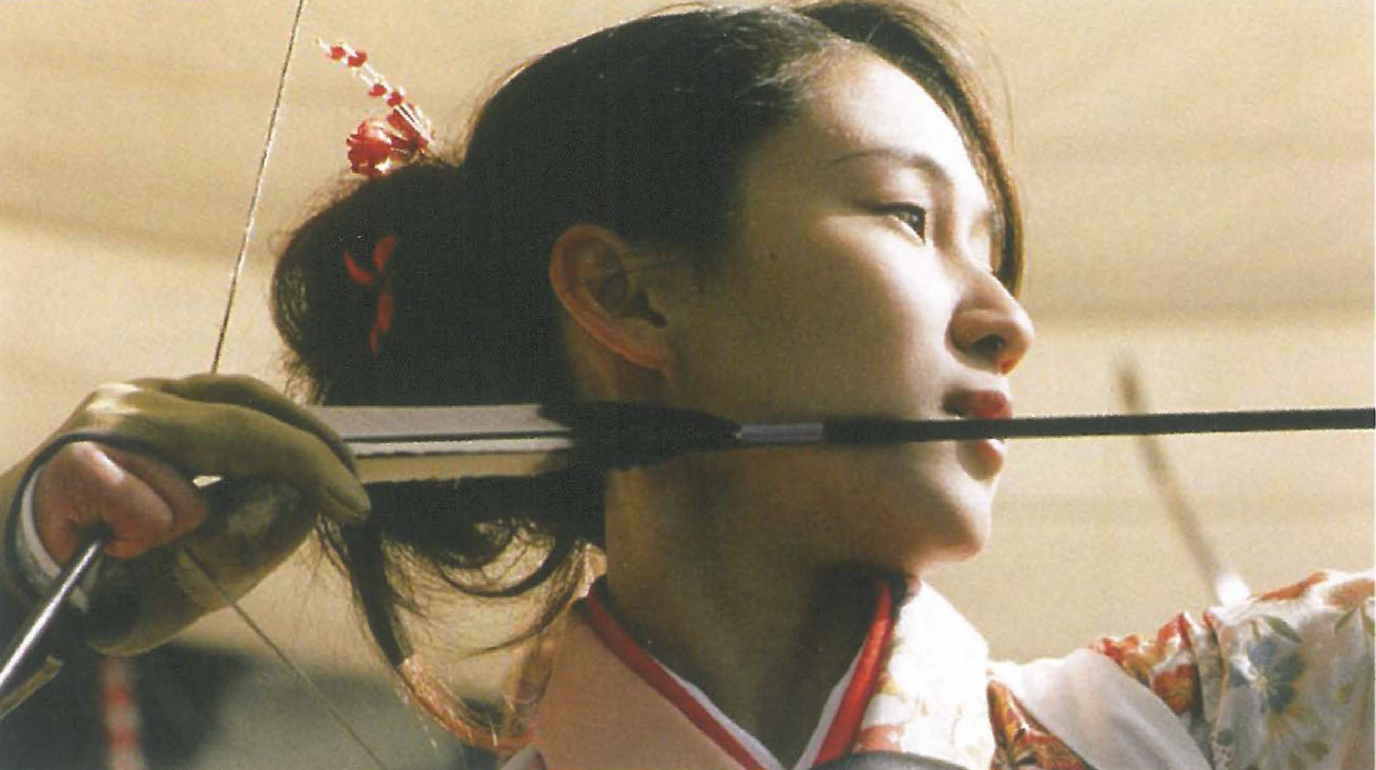
The camera's slow motion take glimpses the nape of a young woman's neck: her pale skin exposed beneath jet-black hair pulled and styled into an elaborate coiffure. A head anterior to hers moves in and out of view, revealing an extending procession of women whose collective gaze scans a distant point beyond the lens's frame. Upright ends of bamboo bows and arrows are nestled close to their chests, and the figures are clad in silky, patterned robes.
A sense of tension pervades the sunlit scene; studied breathing attends a focusing of view before the women assume position and raise their bows. They shift balance. They adjust. The camera slides restlessly across their bodies – a slowed saccadic movement – and jump cuts to close-ups of eyes, wrists and ankles, repeatedly alighting on the women's hair, adorned with baubles, beads and gilt ribbons.
In the darkened interior of Anna Schwartz Gallery, an alternate video screens directly behind this projection: an obverse perspective centring frontally on the women's faces, now revealed as masks of solemn concentration. In this sequence – again in languid tempo – the bows are held overhead and tautly pulled down, poised by gloved fingers, then 'loosed' in succession, leaving the archers' faces mute and blinking.
The young women are participants in a traditional tournament of kyudo, Japanese archery, which celebrates their coming of age and takes place annually at the Sanjusangendo temple in Kyoto. To those unfamiliar with this Zen form of archery, Fiona Tan's St Sebastian can appear primarily as a tableau of exquisite beauty, a conjuring of a particular kind of Japanese femininity. The film is certainly unabashed in its sensualising gaze; loitering on subtly erotic parts of the female body – the ear lobe, the nape of the neck – and irresistibly drawn to the festooned hair. Gliding across the surfaces of skin, silk and bamboo, the camera seems to relish the pageantry of the kyudo ceremony. But only emphasising the aesthetic appeal of St Sebastian can overlook the rigour beneath its style.
In 1923, a German philosopher with a teaching secondment in Japan, elected to take up kyudo to deepen his understanding of Japanese culture and the practice of Zen. Eugen Herrigel apprenticed himself to a master archer, in a course of instruction that was to last six years. Only gradually over this time was he permitted to learn each step in the archer's repertoire. In a written account of the period, he outlined the enormous difficulties of performing each task: from holding the bow, nocking the arrow, drawing and releasing the shot – all requiring considerable strength as well as correct breathing and focus. Unlike in Western archery, the Japanese bow is positioned above the head and opened through a downward pull to a point of maximum tension, which the archer must hold for some time before loosing the shot. Herrigel's concern with mastering technique, however, thwarted his ability to grasp the true thrust of kyudo: an exercise in reaching egolessness or 'right presence of mind'. As his instructor endeavoured to show, the aim of kyudo was not the hitting of the target per se, but the achievement of a state 'in which nothing definite is thought, planned, striven for, desired or expected'.
Herrigel struggled with this form of archery and in his book Zen in the Art of Archery (1953) he reveals it as art in which there is more than meets the eye. Its outward display in fact masks the inner work of the archer in cultivating a Zen state of non-attachment. What one accomplishes through the performance of archery is ultimately internal and invisible. As Herrigel was to learn, the way of the 'artless art' was nothing short of arduous.
The reference to St Sebastian in the work's title is enigmatic. Sebastian, a Roman guard discovered to be a Christian proselytiser and sentenced to death by arrow by the Emperor Diocletian, is a figure in Christian myth connoting persecution for fervent belief. He is emblematised by the arrow, which is clearly a central motif in Tan's work, yet the martyrdom that he signifies seems missing – unless the archers' mental and physical training is itself understood as a form of sacrifice; a necessary forbearance to achieve the still point of the form.
In the second sequence, the camera appears to probe the women's faces – zooming close enough to capture each flaw, freckle and shadowed eyelid. And yet, like their faces after the release of their shot, very little is given away. Behind their shimmering surfaces, the archers' expressions remain impassive. Perhaps this ambiguity is the essence of St Sebastian's seduction: a kernel of inscrutability beyond the splendour of the spectacle.












